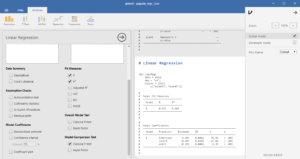Assignment files
Solutions
Developed by Lion Behrens and Rens van de Schoot
This tutorial expects:
- Basic knowledge of correlation and regression
- An installed version of Jamovi on your electronic device
This tutorial provides the reader with a basic introduction to the software package Jamovi. The reader will be guided through the investigation of basic data relations using correlations and through the process of conducting a multiple regression analysis in Jamovi.
Throughout this tutorial we will use a dataset from Van de Schoot, van der Velden, Boom & Brugman (2010). Using multiple regression, we will predict adolescents’ socially desirable answering patterns (sd) from overt (overt) and covert (covert) antisocial behaviour. For more information on the sample, instruments, methodology and research context we refer the interested reader to the paper (see references). Here we will focus on data-analysis only. The data set and syntax file can be found in the subfolders tilted 'Assignment Files' and ‘Solutions’.
Preparation - Loading in your data into Jamovi
There are several ways how you can get your data into Jamovi. For example, you could just copy-past entries of an existing Excel or SPSS file into the data editor that's built in the Jamovi framework. However, this way easily leads to small complications, as e.g. variable names might not be recognized as such. To get the data of this exercise into Jamovi, go ahead and download the popular_regr_1.csv file and import it into Jamovi bi clicking on Open -> Browse -> popular_regr_1.csv.
If you inspect your data closely, you realize that the continuous variables sd, overt and covert have not been recognized as such, but instead are treated as categorical measures. To change this, double-click on the variable names and set the measurement level of each of the three variables to continuous.
Following, check the descriptive statistics of all variables via Exploration -> Descriptives . Do all values substantively make sense?
Exercise 1 - Correlation and Multiple regression in Jamovi
In this exercise you will run a regression model with sd as outcome variable and overt and covert as predictors. Note: In many other "How to get started" exercises you will be asked to compare the results from here with results you can obtain e.g. in R or lavaan. Make sure to save or write down the results you found in this exercise.
Question 1: What do the significance signs and magnitudes of the correlations tell you about the relationships between variables?
Question 2: Play around with the additional options that the Jamovi framework provides you. How do you interpret their results?
Exercise 1b. Now it's time to run the linear regression model described in the introduction. To do so, simply switch to the Linear Regression tab, define sd as the dependent variable and overt/covert as Block 1.
Question: What do you conclude from the regression coefficients? Include the significance and relevance (R2) of effects in your answer.
Note: Jamovi is entirely integrated into the R framework. If you would like to make your analysis reproducible, you can activate the Syntax mode by clicking on the top right of the interface. The syntax mode will provide you with all R code that is needed to reproduce your analysis without pointing and clicking. If your R skills need a little refresher before doing so, get started with R here!
References
Van de Schoot, R., van der Velden, F., Boom, J. & Brugman, D. (2010). Can at Risk Young Adolescents be Popular and Antisocial? Sociometric Status Groups, AntiSocial Behavior, Gender and Ethnic Background. Journal of Adolescence, 33, 583-592.
Why don't you also get started with
MPLUS SPSS Lavaan RJAGS JASP
How to get started How to get started How to get started How to get started How to get started







